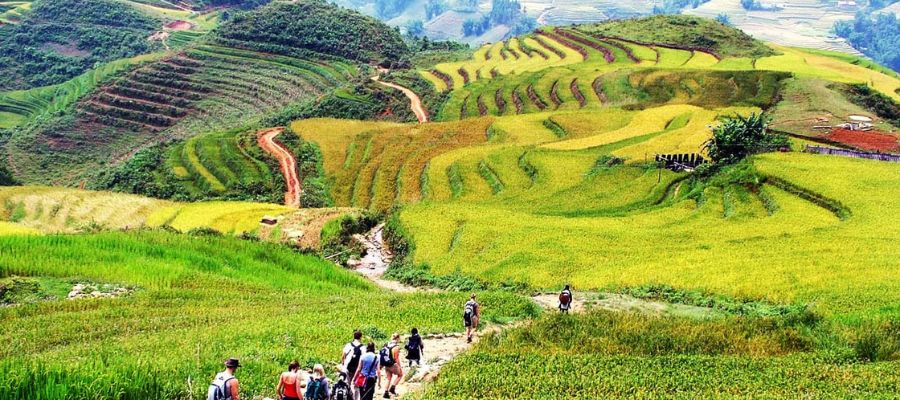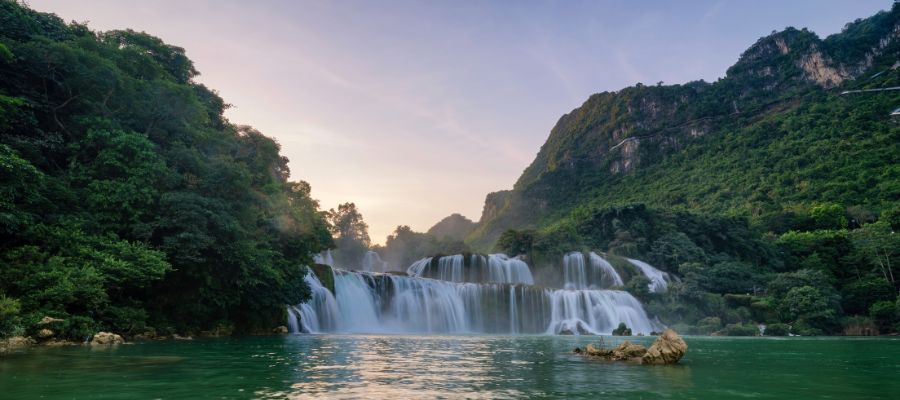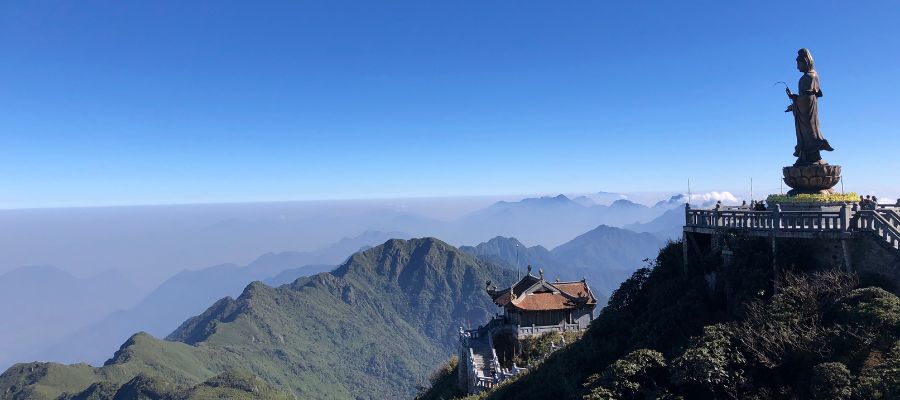The Best Hiking and Trekking Trails in Vietnam: From Mountain Peaks to Lush Valleys
Vietnam is a country of incredible natural beauty, with its jagged peaks, deep valleys, and lush green forests. The best way to explore this stunning landscape is on foot, and hiking and trekking trails are plentiful throughout the country. In this blog post, we will explore the top hiking and trekking trails in Vietnam, from the challenging peaks of the north to the gentle valleys of the south.

10 Best hiking trails for trekking in Vietnam
Vietnam is a country of rugged mountain ranges, verdant valleys, and stunning coastal vistas. It’s also a paradise for hiking and trekking enthusiasts, with trails to suit all skill levels and preferences. From the challenging peaks of the north to the gentle valleys of the south, there are countless opportunities to explore the country’s natural beauty on foot.
In this article, we will introduce you to the 10 best hiking trails for trekking in Vietnam. Whether you’re a seasoned hiker or a first-timer, there’s something on this list for everyone. So pack your bags, lace up your boots, and get ready to discover Vietnam’s breathtaking landscapes!
1. Trekking Sapa Vietnam
Sapa, located in northern Vietnam, is a popular destination for trekking enthusiasts. It boasts stunning natural beauty and cultural diversity, making it a unique trekking experience. Here are some important things to know before trekking in Sapa:
Level of trek: Easy
Best time to trek: March to May or September to November
How to get there: Take a bus, train, or drive a motorbike (only for hardcore riders)
Popular treks: Lao Chai Village, Sin Chai Village, Ta Van Village, Hau Thao Village, Ta Phin Village, and Ban Ho Village
Things to keep in mind: Wear comfortable shoes and appropriate clothing, be aware of the terrain, follow your guide’s instructions, respect local culture and traditions, and take care not to damage the environment.
2. Trekking in Mai Chau
Mai Chau is a perfect choice for those looking for an easy trek in Vietnam. It’s located 150 km from Hanoi and offers a peaceful rural environment to explore. Here are some important things to know before embarking on a trekking adventure in Mai Chau:
Level of trek: Easy
Highlights: Mai Chau is known for its idyllic rural valleys, peaceful ambiance, and laid-back atmosphere. Thac Bo Temple, Thung Khe pass, Mo Luong lake, White Rock pass, Chieu Cave, Go Lao waterfall, and Hoa Binh lake are must-visit places.
Best time to trek: Late September to early May
How to get there: Catch a bus from My Dinh bus station in Hanoi or drive a motorbike on your own.
Popular treks in Mai Chau: Ban Buoc, Cun Pheo, Hang Kia, Mai Chau valley, Pu Luong Nature Reserve, or Cuc Phuong National Park.
Things to keep in mind: Carry cash, bring trekking gear like comfortable shoes, hat, sunscreen, and plenty of water.
3. Pu Luong Nature Reserve (Thanh Hoa)
Pu Luong Nature Reserve in Thanh Hoa is a perfect destination for trekking enthusiasts who want to experience the culture of Thai and Muong people. Here are some highlights and things to keep in mind:
Highlights:
- Stunning natural beauty of terrace rice fields, passes, and large fields
- Opportunity to immerse in the daily life and culture of Thai and Muong people
- Moderate to challenging level of trekking
Best time to trek:
- During the rice harvest season from September to October
- From February to May
How to get there: Take a shuttle bus from Hanoi Old Quarter directly to Pu Luong.
Popular treks in Pu Luong:
- Trek to Pu Luong jungle and visit villages such as Hang, Kho Muong, Kia villages
- Hieu village – Nua village trek
- Nua village – Son village trek
Things to keep in mind:
- Pu Luong is a national forest with restaurants and accommodation available
- No need to worry about overnight stay.
4. Trekking Cat Tien National Park
Cat Tien National Park in Vietnam is a must-visit for nature lovers. Here are some highlights and important information to know:
Highlights: Located between Ho Chi Minh and Dalat, Cat Tien National Park offers a diverse ecosystem with over 400 butterfly species and 79 reptile species. You can spot rare gibbons, wild boars, sambar deer, and more.
Best time to trek: December to May during the dry season.
How to get there: Catch a bus from Ho Chi Minh or ride your own motorbike.
Popular treks in Cat Tien National Park: 30 Botanic Garden Trails, Ban Sau – Crocodile Lake, and Ta Lai Ethnic Village.
5. Trekking in Northern Vietnam – Cao Bang
Cao Bang is a must-visit destination for trekking enthusiasts in Northern Vietnam. Here are the highlights, best time to trek, how to get there, popular treks, and things to keep in mind:

Highlights: Cao Bang offers stunning karst mountain scenery, deep gorges, tiered rice paddies, and stunning waterfalls like Ban Gioc Waterfall, Nguom Ngao cave, Thang Hen Lake, Pac Bo cave, and Ky Sam Temple.
Best time to trek: October to April when the weather is mild and dry.
How to get there: Take a bus from My Dinh or Gia Lam bus station in Hanoi in the morning or evening.
Popular treks in Cao Bang: Ba Be National Park, Pac Po cave-Nam Nhung trek, Tong Cot Village, and Ta Lung border town.
Things to keep in mind: Trekking level is moderate, so have appropriate gear and reasonable fitness. Consider hiring a local guide for a safer and more rewarding experience.
6. Trekking Cat Ba National Park
Cat Ba National Park, located on Cat Ba Island, is a must-visit for anyone looking for an easy-level trekking experience in Vietnam. Here’s what you need to know:
- Highlights: The park offers lush green forests, stunning viewpoints, a museum, a rehab center, and a small zoo.
- Best time to trek: September to October.
- How to get there: Catch a shuttle bus in Nguyen Huu Huan street, Hanoi.
- Popular treks: Kim Giao Forest – Ngu Lam Peak (1.5 km), Trung Trang & Uy Ban Grottoes (1.2 km), National Park HQ – Ao Ech – Viet Hai (14km trekking and walking).
- Things to keep in mind: Fires, tree felling, branch cutting, and hunting are prohibited in the forest. The park closes at 5 pm.
7. Trekking in Ha Giang Vietnam
Ha Giang is a unique and authentic trekking destination in Vietnam that offers stunning views and colorful ethnic minority communities. Here’s what you need to know:
- Highlights: Karst mountains, carpets of flowers, colorful markets of ethnic minorities, Yen Minh, Meo Vac valley, Ma Pi Leng Pass, and Duong Lam village.
- Best time to trek: October to December.
- How to get there: Catch a bus from My Dinh bus station, which takes around 6 to 8 hours.
- Popular treks: Dong Van valley, Si Phai Mountain Village, Trung Son – Bo Dot – Hop Nhat, Tam Son town (Heaven’s gate), and Sky Path: Col de Ma Pi Len.
- Things to keep in mind: The road between Niem Son and Yen Minh is actually a mountain track. The best route is from Meo Vac through Lung Phin.
8. Hiking Lang Biang Mountain
Lang Biang Mountain is a challenging yet rewarding trekking destination in Dalat, Vietnam. Here’s what you need to know:
- Highlights: Stunning natural landscapes, breathtaking views of Dalat City, camping, and abseiling activities.
- Level of trek: Moderate.
- Best time to trek: September to November.
- How to get there: Take local bus No.5 from Da Lat bus station or book an online bus ticket from Ho Chi Minh City.
- Popular treks: Conquering Lang Biang Peak, passing through a vegetable farm, pine trees, and jungle forest before reaching the summit.
- Things to keep in mind: Prepare for physical exertion and bring appropriate gear, respect local culture, and follow trekking rules and regulations.
9. Trekking Fansipan, Vietnam’s Tallest Mountain
Fansipan is Vietnam’s highest peak, standing at 3,143 meters (10,312 feet) above sea level. Located in Sapa, the mountain is known as the ‘Roof of Indochina’ and offers breathtaking views from its summit. The trek to the top is moderate and takes about two to three days.

- Highlights of the trek include serene gardens, beautiful pagodas, and friendly locals. However, due to its accessibility by cable car and easier routes, Fansipan sees around 1,000 trekkers every day. To reach Sapa, you can take an overnight train from Hanoi or catch a shuttle bus.
- The best time to trek Fansipan is from April to May and from September to November. Popular treks include Tram Ton, Tram Ton with a return over Muong Hoa valley – Cat Cat stream (20km), and Doc Mit to the top of Fansipan (for professional trekkers only).
- If you plan to trek Fansipan, you need permission from the Hoang Lien Son management board and should expect to pay around VND 200,000 in fees for trekking, insurance, forest management, and hygiene.
10. Trekking Central Vietnam’s Paradise, Phong Nha Ke-Bang National Park
Phong Nha Ke-Bang National Park is a UNESCO World Heritage Site and home to Son Doong, the world’s largest cave. Trekking in the park is a moderate level experience and offers over 64.6 miles of underground rivers and caves.
- The best time to trek is from February to August. To get to the park, take a bus or train from Hanoi to Dong Hoi city and then a taxi or bus to Phong Nha town.
- Popular treks include a day trek through Paradise Cave and overnight treks through karst mountain scenery, jungle, and caves with breaks at waterfalls and underground rivers. A four-day trek into Son Doong cave is also available for those with ample time and budget.
- Keep in mind that some treks require permits, suitable trekking gear and clothing should be worn, and park rules and regulations should be followed to respect the natural environment.
How to prepare for your Vietnam trek
Vietnam offers many incredible trekking experiences for outdoor enthusiasts. Here are some tips on how to prepare for your Vietnam trek:
- Choose the right season: Vietnam has a tropical climate, so the best time to go trekking is during the dry season, which runs from November to April. During this time, the weather is generally cooler and drier, making it more comfortable for trekking.
- Get the right gear: Make sure you have appropriate gear for trekking in Vietnam, including comfortable hiking shoes, a good quality backpack, a waterproof jacket, and quick-drying clothing. You may also want to bring a hat, sunscreen, and insect repellent.
- Train for the trek: Trekking in Vietnam can be physically demanding, so it’s a good idea to prepare your body for the challenge. Start with regular exercise, such as hiking or jogging, to build up your fitness level. Also, consider doing some strength training exercises to help you cope with the terrain.
- Stay hydrated and well-nourished: Trekking in Vietnam can be hot and humid, so it’s important to stay hydrated by drinking plenty of water. You may also want to bring some snacks or energy bars to keep your energy levels up during the trek.
- Know the route: Before setting out on your trek, make sure you have a good understanding of the route and the terrain. It’s also a good idea to carry a map and compass or GPS device to help you navigate your way.
- Respect the local culture: When trekking in Vietnam, it’s important to respect the local culture and traditions. Be mindful of local customs and dress appropriately. Also, be respectful of the environment and avoid littering or damaging the natural surroundings.
By following these tips, you can ensure that you are well-prepared for your Vietnam trekking adventure and have a memorable experience in this beautiful country.
Best Time to Trek North Vietnam
Late September to October is the ideal time for trekking in Northern Vietnam due to the end of the rainy season and stunningly beautiful scenery. With a pleasantly cool climate, it’s comfortable for hiking, but note that temperatures can drop significantly later in the year.
Therefore, make sure to pack accordingly with appropriate gear, including warm clothing. Enjoy the breathtaking views and be prepared for the changing weather to make the most of your trekking experience in this region.
Best Time to Trek South Vietnam
South Vietnam has a warm and humid climate throughout the year, but the best time for trekking is during the shoulder seasons. The weather is cooler and drier from December to February and from June to August, providing ideal conditions for trekking.
It’s best to avoid trekking during the summer months from March to May, when it can get unbearably hot. Also, avoid trekking during the rainy season from June to November. Plan your trekking adventure accordingly to make the most of your trip to South Vietnam.
Best Time to Trek Central Vietnam
Central Vietnam is prone to typhoons and heavy rainfall during the rainy season, which is from August to November. Trekking during this time can be unpleasant and dangerous. The ideal time for trekking in Central Vietnam is from March to August, after the rainy season has ended.
However, even during this period, it can still be quite wet, and the temperatures may be slightly cooler. From September to November, the weather is drier, but it’s important to note that this is still part of the rainy season. It’s best to avoid trekking in Central Vietnam from August to November to ensure a safe and enjoyable experience.
3 responses to “The Best Hiking and Trekking Trails in Vietnam: From Mountain Peaks to Lush Valleys”
Recent Posts
Other Info
- Turkey Visas for Tourism, Business Purposes
- Apply for Turkish Student Visa
- Turkey Work Visa or Work Permit
- Turkey Transit Visa
- Turkey Residence Permit
- Turkish Visa
- E Visa of Turkey
- Visa for Turkey US Citizen
- Turkey Visa for Pakistani
- Electronic Visa Turkey
- Turkey Travel Visa
- Visa on Arrival Turkey
- US Citizen Travel to Turkey
- Chinese Embassy Turkey
- Visa for Turkey From Canada
- Visa Required for Turkey
- Visa Transit Turkey
- Turkey Transit Visa for US Citizens
- Form for Entry to Turkey
- Turkey Visa for US
- Visa Requirements for Turkish Citizens
- Need Urgent Turkey Visa?
- Turkey Visa Information
- Turkey Essential Guidelines for U.S. Citizens
- US Visa for Turkey
- Passport for Turkey
- Turkey Visa Online
- Turkey Visa for Indian
- Turkish Visit Visa
- Visa Application Form Turkey
- E Visa Turkey Cost
- Tourist Visa to Turkey
- Visa Application to Turkey
- Apply Visa to Turkey
- Traveling to Turkey From Canada
- Getting a Visa for Turkey
- Visa Cost Turkey
- Kenya E Visa
- eVisa Kenya Online
- Kenya Online Visa
- Kenya e-Visa
- Kenya Entry Requirements
- Kenya Visa Requirements for US Citizens
- Kenya Visa for US Citizens
- Vaccines For Kenya
- Yellow Fever Vaccine Kenya
- Yellow Fever Certificate Kenya
- Vaccinations Required For Kenya
- Kenya Transit Visa
- Kenya Multiple Entry Visa
- Kenya Business Visa
- Kenya E Visa Fees
- Kenya eVisa Cost
- Kenya evisa Application
- Kenya Online Visa Application
- Kenya evisa Processing Time
- Kenya Visa on Arrival
To start applying online click on 'Apply Now' Button
I pay a visit every day a few sites and blogs to read posts, however
this blog provides quality based writing.สูตรสล็อตออนไลน์
This is the perfect site for anyone who would like
to understand this topic. You understand a whole lot its almost hard to argue with you (not
that I really would want to…HaHa). You certainly put a new spin on a
topic that has been written about for decades. Great stuff, just great!หลักการเล่นสล็อตออนไลน์
kinno hd